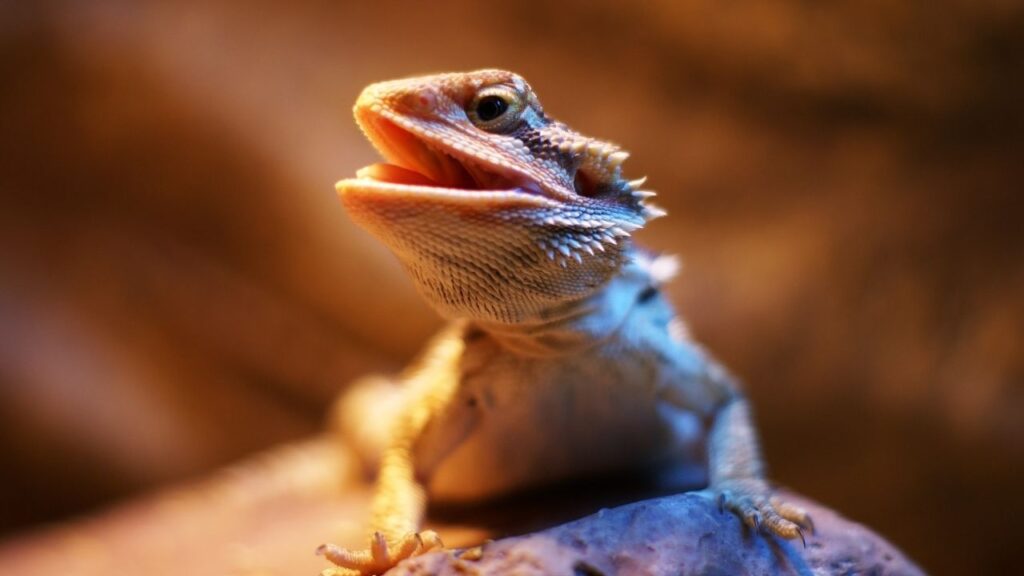Bearded dragons can swim and are capable of floating by inhaling air. They may not be the most graceful swimmers, but they can paddle through the water using their limbs.
Swimming is not a common activity for bearded dragons in the wild, but they can swim if given the opportunity.

1. The Aquatic Abilities Of Bearded Dragons
Bearded dragons are fascinating creatures known for their unique appearance and interesting behaviors. While they are primarily terrestrial animals, they do possess certain aquatic abilities that may surprise you. In this section, we will explore the swimming capabilities of bearded dragons and provide insights into their preferences and techniques when it comes to swimming.
1.1 Can Bearded Dragons Swim?
Yes, bearded dragons can swim! Although they are not natural swimmers like some amphibians or aquatic reptiles, they are capable of swimming when necessary. Unlike turtles or frogs, bearded dragons do not spend much time in water in the wild. However, they have adapted to the occasional need for swimming, which can be observed in captive environments or during specific situations in their natural habitat.
1.2 How Do Bearded Dragons Swim?
When bearded dragons swim, they utilize a unique technique that sets them apart from traditional swimmers. Rather than using their limbs to paddle through the water, they rely on a combination of doggy-paddling and tail propulsion. This means that they use their hind legs primarily for steering and stability, while their tails serve as the main source of propulsion.
During swimming, bearded dragons keep their bodies relatively flat, with their legs tucked in close to their side. This streamlined posture helps them move efficiently through the water. While swimming, they also use their heads and necks to maintain balance and control their direction. This swimming technique allows bearded dragons to navigate through water without expending too much energy.
1.3 Do Bearded Dragons Like To Swim?
Bearded dragons have mixed opinions about swimming. While some individuals may enjoy swimming and willingly enter the water, others may feel uncomfortable or anxious in aquatic environments. This preference can vary from dragon to dragon and may depend on their previous experiences or personal temperament.
It’s important to note that not all bearded dragons are natural swimmers, and some may show signs of distress or panic when placed in water. If you decide to introduce your bearded dragon to swimming, it’s crucial to monitor their behavior closely and provide a safe and controlled environment. Always take into consideration the individual preferences and comfort level of your specific dragon.

2. Significance Of Swimming For Bearded Dragons
As reptiles, bearded dragons are naturally adapted to an environment that includes water. Although they originate from arid regions such as Australia, they do possess the ability to swim. Swimming holds a significant place in the lives of bearded dragons for various reasons. In this section, we will explore the benefits of swimming for these fascinating creatures, as well as the risks and precautions associated with this activity. Additionally, we will discuss how to incorporate swimming into bearded dragon care, ensuring their well-being and health.
2.1 Benefits Of Swimming For Bearded Dragons
Water as Hydration: While bearded dragons primarily obtain water through their food intake, providing them with a shallow water dish can serve as an additional hydration source. Swimming allows them to drink water directly, further ensuring their overall hydration levels.
2.2 Risks And Precautions Of Swimming For Bearded Dragons
Risk of Drowning: While bearded dragons can swim naturally, it is crucial to exercise caution and maintain vigilant supervision during their swimming sessions. Although rare, there is always a risk of accidental drowning. Always provide a safe and shallow swimming area, ensuring they can easily reach the surface to breathe.
Chlorine and Chemicals: Chlorinated or chemically-treated water can be harmful to bearded dragons. It is essential to use non-chlorinated water or water specifically treated for reptile habitats. The presence of chemicals can negatively impact their skin and respiratory system.
Temperature Control: Bearded dragons require specific temperatures to maintain their health. When swimming, ensure the water temperature does not exceed or fall below their optimal temperature range. Sudden temperature changes can result in stress or shock for these creatures.
2.3 Incorporating Swimming Into Bearded Dragon Care
Supervised Interaction: Bearded dragons should always be supervised when swimming. This allows you to monitor their behavior, ensure their safety, and intervene if necessary. Only provide a suitable swimming area and ensure they do not tire themselves out excessively.
Regular Cleaning: Regularly clean the swimming area to maintain good hygiene. Remove any excrement or debris from the water and disinfect the swimming area to prevent the growth of harmful bacteria or parasites.
Gradual Introduction: Introduce bearded dragons to swimming gradually, starting with short sessions and gradually increasing the duration. This gradual approach helps them acclimate to the water and reduces any potential stress or anxiety.
By considering the benefits, risks, and precautions associated with swimming, you can safely incorporate this activity into your bearded dragon’s care routine. With proper supervision and attention to their well-being, swimming can become an enjoyable and beneficial experience for these fascinating reptiles.
3. How To Safely Introduce Bearded Dragons To Water
Introducing your bearded dragon to water can be an exciting and enriching experience for both you and your pet. However, it’s important to proceed with caution and ensure their safety at all times. In this section, we will look at three essential steps to safely introduce bearded dragons to water and make the experience enjoyable for them.
3.1 Providing A Suitable Water Source
The first step in introducing your bearded dragon to water is to provide a suitable water source. Bearded dragons are used to desert-like environments, so it’s essential to mimic their natural habitat as closely as possible. Here are some key points to consider:
- Use a shallow and wide water dish that allows your bearded dragon to comfortably walk in and out of the water.
- Make sure the water is at an appropriate temperature, around 85-90 degrees Fahrenheit (29-32 degrees Celsius), which is similar to their preferred basking temperature.
- Ensure the water is clean and free from any chemicals or contaminants. Using tap water may require treating it with a reptile-safe water conditioner to remove chlorine and other potentially harmful substances.
3.2 Gradually Introducing Bearded Dragons To Water
Bearded dragons may be hesitant to enter the water initially, especially if they are not familiar with it. To ease their transition and make them feel more comfortable, follow these gradual introduction methods:
- Start by placing your bearded dragon near the water dish, allowing them to observe it from a safe distance. This helps them become familiar with the water source.
- Next, you can try gently misting their body with lukewarm water using a spray bottle. This simulates rainfall and can help them become accustomed to the feeling of water on their skin.
- Once they seem more comfortable, you can encourage them to walk into the shallow water dish by placing treats or their favorite food near the edge. This positive reinforcement can motivate them to explore the water.
3.3 Supervising And Monitoring Bearded Dragons While Swimming
While bearded dragons can swim, it’s important to always supervise and monitor them closely during their swimming sessions. Here are some guidelines to ensure their safety:
| Do: | Don’t: |
|---|---|
|
|
By following these safety measures and gradually introducing your bearded dragon to water, you can create a positive experience that promotes their physical and mental well-being. Remember to always prioritize their safety and enjoyment when incorporating water into their routine.
FAQ
Do Bearded Dragons Recognize Their Owners?
Bearded dragons can recognize their owner’s voice and scent, showing signs of comfort and familiarity. This can create a special bond between them, although it may not be considered love.
Why Is My Bearded Dragon Opening His Mouth At Me?
Bearded dragons open their mouths as part of their aggressive stance when they feel threatened or afraid. It is not a sign of affection or a yawn.
What Happens When A Bearded Dragon Inhales Water?
If a bearded dragon inhales water, it may develop respiratory problems, such as swelling or infection in the lungs or airways. However, if the dragon is breathing well and alert, it will likely be okay. Signs of distress include open-mouthed breathing and abnormal body posture.
Make sure to monitor their condition closely.
Do Bearded Dragons Actually Drink Water?
Yes, bearded dragons do drink water. They mainly get water from their food, but it’s still important to provide them with a water bowl. They can also drink while being bathed.
Conclusion
Bearded dragons can indeed swim. While they may not have many opportunities to swim in the wild, they are capable of swimming. They use their limbs to paddle through the water after inhaling air to help them float. Although they may not be the most graceful swimmers, they are able to navigate through water.
So, if you have a bearded dragon as a pet, don’t be afraid to provide them with a safe and supervised swimming experience!
